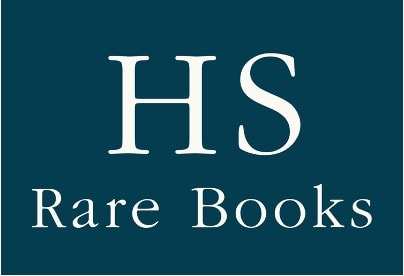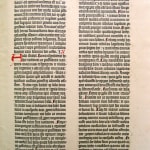![Gutenberg, Johann, [Biblia Latina], [ca. 1455]. [Mainz]. [Johann Gutenberg & Johann Fust].](https://artlogic-res.cloudinary.com/w_1600,h_1600,c_limit,f_auto,fl_lossy,q_auto/artlogicstorage/hsrarebooks/images/view/e8c2819fcf3bbbd9cf47c4a8acdeb940j/hsrarebooks-gutenberg-johann-biblia-latina-ca.-1455-.-mainz-.-johann-gutenberg-johann-fust-..jpg)
![Gutenberg, Johann, [Biblia Latina], [ca. 1455]. [Mainz]. [Johann Gutenberg & Johann Fust].](https://artlogic-res.cloudinary.com/w_1600,h_1600,c_limit,f_auto,fl_lossy,q_auto/artlogicstorage/hsrarebooks/images/view/9b5036bc113d0f155baf4e7b2ae8ae4ej/hsrarebooks-gutenberg-johann-biblia-latina-ca.-1455-.-mainz-.-johann-gutenberg-johann-fust-..jpg)
![Gutenberg, Johann, [Biblia Latina], [ca. 1455]. [Mainz]. [Johann Gutenberg & Johann Fust].](https://artlogic-res.cloudinary.com/w_1600,h_1600,c_limit,f_auto,fl_lossy,q_auto/artlogicstorage/hsrarebooks/images/view/20193cefde2d889c3c68d39dc37935d2j/hsrarebooks-gutenberg-johann-biblia-latina-ca.-1455-.-mainz-.-johann-gutenberg-johann-fust-..jpg)
![Gutenberg, Johann, [Biblia Latina], [ca. 1455]. [Mainz]. [Johann Gutenberg & Johann Fust].](https://artlogic-res.cloudinary.com/w_1600,h_1600,c_limit,f_auto,fl_lossy,q_auto/artlogicstorage/hsrarebooks/images/view/0286d9fca4fe71f8a86a87b44a61a0cfj/hsrarebooks-gutenberg-johann-biblia-latina-ca.-1455-.-mainz-.-johann-gutenberg-johann-fust-..jpg)
Gutenberg, Johann
First edition, a textually significant leaf from the first substantial book printed from movable type in the western world, now known simply as the Gutenberg Bible, or the 42-line Bible: “in many ways the greatest of all printed books” (PMM 1). This leaf is a particularly interesting one, as it contains Deuteronomy IX and most of X, commanding the making of the Tablets after the destruction of the first.
Further images
A single paper leaf from the Gutenberg Bible, comprising the full Deuteronomy IX and most of Deuteronomy X; two rubricated initials. Single leaf, royal folio (390 x 285 mm), double columns, 42 lines per column, gothic letter, initial spaces, central bull’s head watermark. With rubricator’s headlines, lombard capitals in red and blue alternating. Excellent condition, no worming, slightly corrugated margins, inner margin strengthened. [Mounted in:] A Noble Fragment: being a Leaf of the Gutenberg Bible, 1450-1455, with a Bibliographical Essay by A. Edward Newton [designed by Bruce Rogers and printed by William Edwin Rudge]. 1921. New York. Gabriel Wells. pp. [6], text in double columns, with title-page and one initial letter printed in red. Original full black blindstamped goat-skin by Stikeman & Co., covers lettered in gilt, some minor rubbing at edges.
“At that time the Lord said to me, Chisel out two stone tablets like the first ones and come up to me on the mountain. Also make a wooden ark. I will write on the tablets the words that were on the first tablets, which you broke. Then you are to put them in the ark… So I made the ark out of acacia wood and chiseled out two stone tablets like the first ones, and I went up on the mountain with the two tablets in my hands. 4 The Lord wrote on these tablets what he had written before, the Ten Commandments he had proclaimed to you on the mountain, out of the fire, on the day of the assembly.”
The development of typographical printing in Europe during the second half of the 15th century marks a turning point in the history of mankind, it pro the ability to disseminate and store knowledge and literature as never before and changed the character of western civilization. It was printed in 600 copies.
“It has been claimed that the craft of letterpress printing is the medium which turned the darkness of the Middle Ages into light; which secured to posterity the intellectual achievements of the past; and which furnished to civilization a means of recording all future progress” (Britannica). The Gutenberg Bible was printed in an edition of probably 45 copies on vellum and 135 on paper, of which 48 or 49 complete or nearly complete copies are extant.
The Gutenberg Bible was the first book printed from movable type in the Western hemisphere. Only forty-eight copies of it are known, most of which are incomplete. This leaf was removed from the imperfect Mannheim Court Library, later Munich Royal Library, Robert Curzon (Lord Zouche), and Sabin, before being acquired by the New York bookseller Gabriel Wells at Sotheby’s, 9 November, 1920. Wells broke up the copy in 1921 and offered the leaves separately, bound along with A. Edward Newton’s eloquent essay.
“Its printers were competing in the market hitherto supplied by the producers of high-class manuscripts. The design of the book and the layout of the book were therefore based on the book-hand and manuscript design of the day, and a very high standard of press-work was required, and obtained, to enable the new mechanical product to compete successfully with its hand- produced rivals. Standards were set in quality of paper and blackness of ink, in design and professional skill, which the printers of later generations have found difficult to maintain” PMM.
Hain 1826, *3031; BMC I, p. 17; De Ricci 1911, no. 34; GW 4201 (“about 1454/55, not after August 1456”); Goff 1964, B-526; Meuthen 1982; Carter/Muir 21983, no. 1; exh. cat. Boston 2000, no. 63; Schneider, C. 2000; White 2000; ISTC ib00526000.
Provenance
1. From the incomplete copy of Maria Elisabeth Augusta von Sulzbach (1721-1794), wife of Karl Theodor, Count-Palatine and Duke of Bavaria and Sulzbach (the coat-of-arms of Carl Theodor and his first wife Maria Elisabeth was stamped on the previous binding), Electoral Prince of the Palatinate, subsequently Electoral Prince of Bavaria (1724-1799);
2. Hofbibliothek at Mannheim Court Library. After Karl Theodor’s death to;
3. Munich, Royal Library, sold as a duplicate in 1832;
4. Later on in the possession of Robert Curzon, 14th baron Zouche (1810-1873) by descent to;
5. Baroness Zouche of Haryngworth;
6. Sotheby’s, 9th November 1920 (Zouche sale), n° 70;
7. Joseph Sabin, sold to;
8. Gabriel Wells, who broke up the copy, dispersing it in single leaves or larger fragments;
9. Private collection, England.
Join our mailing list
* denotes required fields
We will process the personal data you have supplied in accordance with our privacy policy (available on request). You can unsubscribe or change your preferences at any time by clicking the link in our emails.




